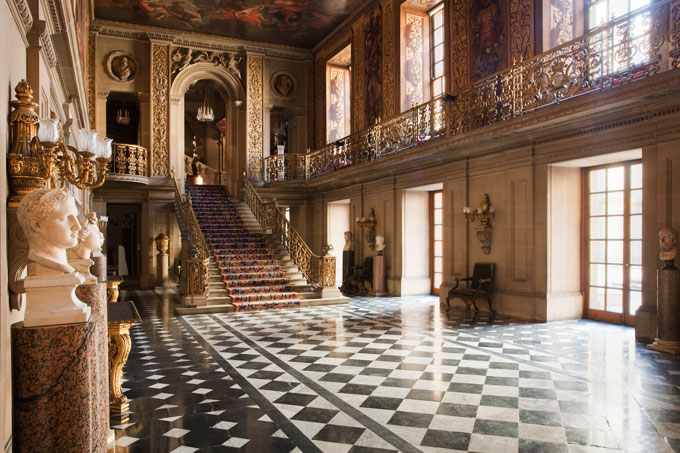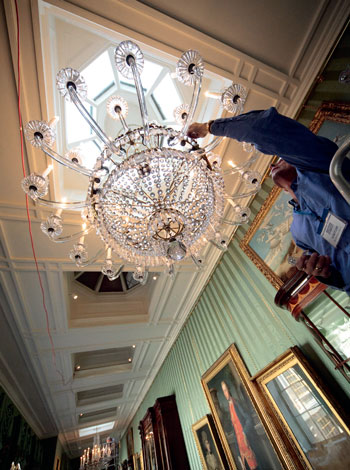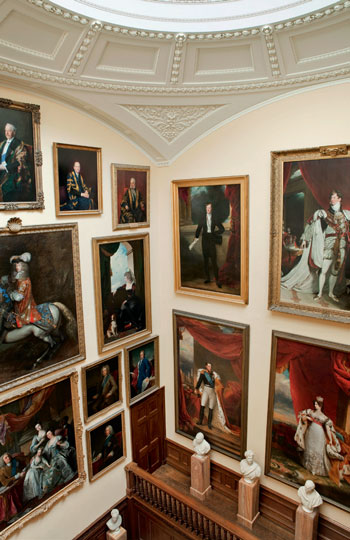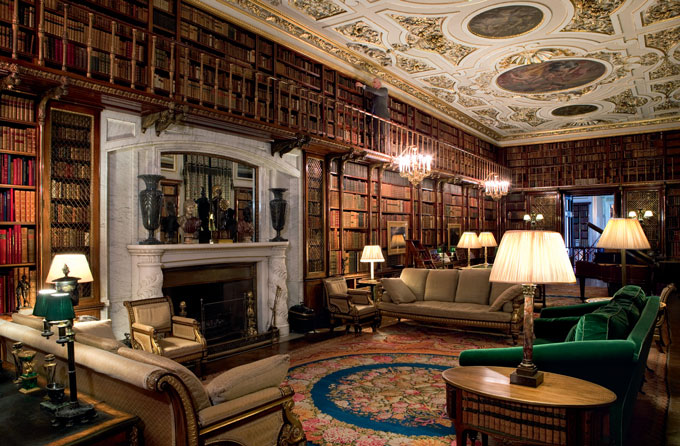We go behind the scenes at the magnificent mansion of Chatsworth House, home to the Dukes of Devonshire since 1549 and the location for The Duchess (2008) featuring Keira Knightley

Approached through 400 hectares of parkland, Chatsworth House is a vision of serenity at the heart of Derbyshire’s Peak District National Park. But like a swan gliding on a river, that gorgeous tranquillity conceals bustling activity, hidden from visitors enjoying one of England’s finest stately homes.
Beneath Chatsworth’s half-a-hectare lead roof there are over 300 rooms, 17 staircases, 459 windows and 2,084 lightbulbs. Looking after this stately pile requires the services of housekeepers, plumbers, electricians, seamstresses and joiners. The priceless art objects contained within benefit from the care of curators, archivists, textile conservators and a photo librarian. And that is just the house – outside work gardeners, foresters, gamekeepers, stockmen, farmers, shepherds, river-keepers, brewers and land-agents. The farm shop employs butchers, bakers and fishmongers, and the restaurants have a busy staff of chefs and servers. Last but not least are the friendly faces of the front-of-house team and the guides. At the centre of this hive of activity are the present Duke and Duchess, busy working on their ‘masterplan’ for restoring, preserving and enhancing Chatsworth.

A house as grand and busy as Chatsworth never truly sleeps: “There is never a moment when there isn’t a team here at Chatsworth. Even when we are tucked up in our beds we have pagers ready to go off if there is a flood or a fire,” says Christine Robinson, Head Housekeeper.
Visitors enter Chatsworth House through the South Front and arrive in the extraordinary Painted Hall, a fitting opening to the 1st Duke’s grand project to build a palace fit to host King William III and Queen Mary II, whom he helped bring to the throne during the Glorious Revolution of 1688, earning himself his ducal status.
The royal pair never made their proposed visit, but the result was a magnificent State Apartment, which captures the baroque ethos of the time, infused with theatricality, illusions, painted decoration and whimsy.
William and Mary were also the inspiration for the stunning collection of delftware vases – the fashion for which was started by their Majesties’ Dutch origins. The vases are housed in the Great Chamber, which was intended as a gathering place for those seeking an audience with the king and queen. The magnificent painted ceiling by Verrio contains a portrait of the 1st Duke’s Housekeeper Mrs Hackett. They apparently fell out and Verrio immortalised her in the classical scene as the vengeful Fate, Atropos.
Current Head Housekeeper Christine need not fear any mischievous tributes from her hardworking and dedicated staff: “The visitor route is half-a-mile long, which all gets vacuumed and dusted every day. Some things require extra attention, for which we train the staff specially, but we also have specialist staff working with the Collections Team, looking after silverware and the boulle (woodwork inlaid with brass and tortoiseshell) and so on.

One cache of precious treasures is in the State Bedchamber. This room houses the King’s Bed, which was reputedly made in 1723 for George II and was acquired by the 4th Duke as a perquisite in 1761. The bed is hung with crimson and gold and as the original curtains disintegrated in the sunlight, exact reproductions were made by Chatsworth’s in-house seamstresses, each one representing around 480 hours of handwork.
Christine’s day also revolves around long-term plans for the house, and the many annual events held there including Floribunda, the flower festival, and of course, Christmas.
“At the moment I’m planning the Christmas opening. We have to start buying things and commissioning now, so we start our Christmas shopping early.
“Then when we close after Christmas we have a fairly small window, until 10 March, to get the deep clean of the house done. That’s a military operation.” The behind-the-scenes operations at Chatsworth might be a military operation now, but in times past the amount of servants required to keep the Cavendish family in comfort and luxury resembled a small army. Even so for much of the year, the family would be away, following a strict timetable of Ireland for the salmon fishing, Devonshire House in London for the Season, then to Bolton Abbey for the grouse shooting in August and then back to Chatsworth for a huge family gathering for Christmas, and New Year.
The Prince of Wales quite often came for Twelfth Night, and the king came for the pheasant shoots. As well as guests, Chatsworth would have seen a huge influx of personal staff. There may have been up to 100 guests staying at any one time, and 150 servants looking after them, plus extra help drafted in from the village.
Christine’s family were among those staff: “My grandmother was born on the estate. She started working here when she was 12. Her brother was the chauffeur to the 9th Duke, and was with him when they changed from horse and carriage to motorcar. The recipe I have for Chatsworth Christmas pudding has been passed down from my grandmother, and it’s a family secret,” she says.
Christine’s favourite room is the Library. Here guests would gather for dinner and admire the books, of which Chatsworth has nigh on 40,000, including precious first editions and the original works of philosopher Thomas Hobbes, who tutored the 2nd and 3rd Earls. There is a hidden door which leads to a secret spiral staircase, and in a side table can be found a bullet hole, a result of ‘friendly fire’ during WW2, when American infantry were stationed here.

Next to the Library is the Dome Room, where the 6th Duke would assemble his guests to be partnered for dinner, manoeuvring them through the relatively small space in order to make a spectacular impression when they finally filed into the Great Dining Room for a nine-course dinner.
This sumptuous room, lined in red silk, is dominated by the Great Chandelier and vast banks of silverware on the huge table. It takes a Collections Steward around 40 hours to polish the silver. During dinner, the room was lit by 48 candles and once they had burnt down to the end of the wick, dinner was finished, to be followed by music, charades and smoking (for the gentlemen only, of course!).
The very first dinner held in the Great Dining Room was in honour of the 13-year-old Princess Victoria; her first banquet as an adult. Guests would have been served by butlers and footmen in full livery, bringing in course after course of elaborate dishes from kitchens supplied by the estate farms and parks, at a table decorated with flowers from the gardens and conservatories, and ice sculptures from the ice house. Today, the Duke and Duchess only use the Great Dining Room for very special occasions.
Despite the rich history of Chatsworth, the house is no stranger to modernity. Christine adds: “The 12th Duke and Duchess live here all the year round, and it is very much their family home. It reflects the taste and style of every occupant. The new works of art can be quite controversial, but I think the Duke likes that.” Traditionalists, however, will be pleased to know that during 2012 many of Chatsworth’s Old Masters, including Rembrandt, Da Vinci and Titian, are on display for the first time in 100 years.
Another draw of Chatsworth is its wonderful gardens. The 1st Duke created the formal gardens, a stunning swathe of greenery, sliced through by the dramatic Cascade, a stone staircase rippling with water. The 4th Duke then commissioned Capability Brown to transform the garden in the fashionable naturalistic landscape style, while the 6th Duke hired Joseph Paxton, who built the Great Conservatory that supplied the house with fruit and flowers all year long. Paxton then went on to design the famous Crystal Palace. The site of the Great Conservatory now holds the maze, which is made of 1,209 English yews.
It is a tribute to the hard work, commitment and passion of Chatsworth’s family and staff that it is one of England’s top visitor attractions and a source of inspiration to art and history lovers everywhere. In the words of Mary Keen, writing about the house: “The scale may be awesome and the window frames gilded, but the chickens cluck about the place and the work carries on.”
Chatsworth is open every day until 23 December. The house is open from 11am-5.30pm (4.30pm last admission). The garden is open from 10.30am-5pm during summer months and 11am-6pm (5pm last admission) at all other times. For more information, entry prices and any changes to opening times, visit www.chatsworth.org
Related articles
Dreaming up inspiration at Chenies Manor Gardens
Behind the scenes at Parham House





 © 2024
© 2024